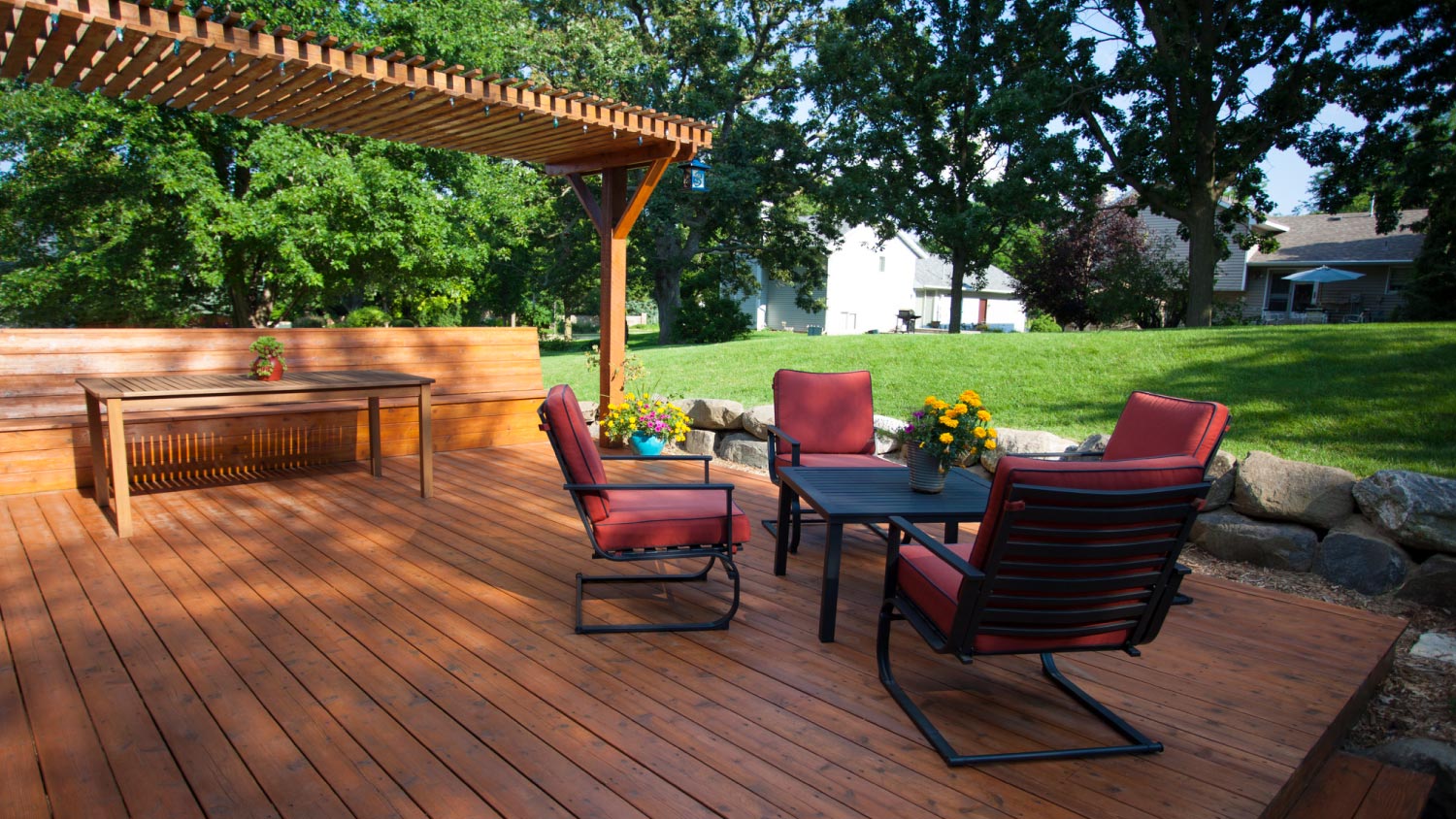
Refinishing your deck is a great way to restore its appearance and fall in love with your outdoor space. Use this guide to learn how much it costs based on factors like size and type.
Your deck is a place of ultimate relaxation; make sure it stays that way


One of the best ways to enjoy the warm weather is by sitting outside on your deck. To make the most of your time in your outdoor oasis, you’ll want to ensure it's as safe as possible for you, your family, and any guests coming to visit. If you plan to host cookouts or spend your nights and weekends in your backyard retreat, read on for the deck safety checklist that will keep your space in the best shape possible.
Working on a deck isn't without its hazards. Be on the lookout for poison oak, ivy, and other poisonous plants as you build, and be sure to take proper safety precautions to decrease your risk of splinters, overexertion, and chemical exposure from paint and sealants while working.
Over time, wood can rot and weaken the structure of your deck. Wet weather can result in rotting, meaning that those of you living in rain- and snow-prone areas of the country, like the southeast and far north, should pay special attention to your deck’s moisture levels. Insect infestation can also lead to rotting.
If you’re unsure if your deck has rotted, poke the suspected area with a screwdriver. If the screwdriver goes into the wood more than 1/8 of an inch, it’s likely rotten.
If you painted your deck, you might be able to tell if the wood is rotten by seeing if there’s a lot of flaking or chipping on the wood’s surface. Excessive flaking and chipping could indicate that moisture has gotten under the paint and caused the boards to rot.
Replace any rotten wood you see, or consider hiring a deck builder near you to make a full assessment of the damage and take care of this task.
To prevent the wood from rotting, consider staining your deck.
A common outcome of rotted wood is that fasteners (aka any screws or nails used to keep the deck in place) can become loose. If your wood is rotten, it will be too soft to properly hold the fasteners in place and can be a major safety risk. However, this isn’t the only time you should replace your nails and screws.
If nails and screws are loose and poking out of rotten wood, replace the problematic deck boards.
Inspect your deck to see if any other fasteners are rusted or loose and need replacing.
Only reuse fasteners that are in good condition (not loose or rusted).
Replace compromised fasteners to maintain the structural integrity of your deck.
The wood on your deck can become cracked and experience other signs of wear, such as creaks or pops, as you walk on the surface. While these sounds may create a perfect atmosphere for a suspense movie, it’s the last thing you want to hear from your deck.
Take notice of any existing cracks in the wood, big or small.
Keep an eye on the cracks to determine if they’re growing and could become a hazard.
Fix small cracks early and prevent bigger, more costly issues by filling the cracks with caulk or epoxy.
If you hear creaking or popping in certain areas where a crack isn't visible, check underneath the deck to see if it's cracked there.
If you can't figure out what's causing the creaking or popping, hire a local home inspector to take a look.

Railings can face quite a bit of traffic on decks, especially near steps. Years of people holding on as they go down the stairs can cause railings to loosen.
Tighten hardware on railings to avoid a safety issue.
Perform regular maintenance to help you save on the cost of completely replacing your deck railings, which could run you around $925.
For decks on upper levels, check the railings consistently to keep yourself, your family, and your guests safe. A good rule of thumb is that a 200-pound person should be able to push against a railing and only feel a slight give.
If the railings feel loose, inspect them to determine the cause. Common causes of loose railings are rotten wood, loose fasteners, and cracks.
Since the 1980s, wood treatment facilities have prepared deck lumber with a chemical that repels bugs, according to the EPA. The wood your home is made of, however, may not be treated in the same way. Bug damage that’s severe enough could affect the part of your home that’s attached to your deck and cause the deck to pull away from your home.
A deck should stay in the position in which you or your pro built it.
If the deck is pulling away, you may notice a significant gap between the wood and your home’s siding.
If it appears your deck is no longer in its original place, it's a good idea to call an inspector to come and check it out.

If possible, take a look at the structure of the underside of your deck. Under your deck and flush against your home is a ledger board that attaches your deck to your house.
Ensure the ledger board is secure with no loose hardware or cracking wood because if it isn't, your deck is at risk of collapsing.
Hire a contractor near you to fix the ledger board if it isn’t secure.
If your ledger board is severely damaged, a pro can use other attachments, like a steel framing ledger, to secure your deck in place and avoid further risk.
You may notice a green tinge on your deck now and then. The discoloration may not look great cosmetically, but it won't cause immediate damage to your deck. However, if you start to notice fuzzy mold or growths that look like mushrooms, tend to them as soon as possible.
Mold and mildew will eat away at the structure of your deck, but you can slow their growth by scrubbing your deck with a mild soap and some water.
Keep a consistent cleaning schedule for your deck—at least twice per year—to prevent mold and mildew.
You may love dining on your deck in the evening, but if no one has installed proper lighting in the area, it can be difficult to find your way around. From slipping risks to critters, an unlit deck can hide all kinds of safety concerns.
Choose lighting fixtures that add both ambiance and function to the space.
Putting string LED lights or uplights on the deck and steps can create a well-lit area that still feels like a relaxing retreat.
If you want to install brand new fixtures that require new wiring as opposed to using something like string lights that you can easily hang up on your own, you should contact a professional.
A certified electrician near you can ensure that your new deck isn’t subject to fire or electrocution hazards that can come with wiring new lighting.
Grilling is one of the best ways to enjoy your outdoor space. For ultimate deck safety, practice proper grilling protocols to avoid burning or damaging your deck during your next barbecue.
Place your grill at least 2 feet away from furniture, siding, railings, overhangs, and any other areas that could become damaged from close proximity to fire or smoke.
Trim any branches that are hanging too close to the grill.
Keep a fire extinguisher close to where you’ll be cooking.
Put any hazardous and flammable materials, such as lighter fluid, in a storage box away from the grill.
The best way to stay proactive in deck safety is to follow a regular inspection and maintenance schedule to address any issues with your deck's structure before they become safety hazards.
Have your deck inspected every five years, especially if it’s over 10 years old. Basic deck inspections cost between $150 and $300, but more detailed inspections to evaluate a deck’s structural integrity can cost $300 to $800.
If you live in close proximity to water or in an exceptionally rainy area of the country, follow yearly inspections to address any water damage.
On average, building a deck costs $8,200, or around $30 to $60 per square foot. Basic designs using lower-end materials can cost as little as $4,350 while more elaborate designs with nicer materials can easily cost $12,500 or more.
Building a deck is not easy and requires a high level of experience in multiple disciplines. Even if you have the experience, this is a lengthy, in-depth project that is physically challenging and requires a massive time commitment. If you make a mistake, your deck could suffer from defects that may undermine its structural integrity to the point where it’s completely unsafe to use. Hiring someone to fix it may cost more than you would have paid to hire a pro in the first place.
Your best option is to hire an experienced deck builder who can build a structurally sound and attractive deck the first time around.
From average costs to expert advice, get all the answers you need to get your job done.

Refinishing your deck is a great way to restore its appearance and fall in love with your outdoor space. Use this guide to learn how much it costs based on factors like size and type.

Are your porch columns old or simply unsightly? It might be time to refresh them. Here's a breakdown of the cost of replacing porch columns.

Cedar is a popular decking material, best known for its natural wooden look and resistance to rot. So, how much does a cedar deck cost? Find out in this guide.

You can DIY a floating deck with the right layout, materials, and installation method. Here’s everything you need to know about how to build a floating deck.

If you’re wondering—who can I get to refinish my deck?—you’re in the right place. Learn who you can hire to refinish your deck if you aren’t up for the DIY.

If your deck is in bad shape, this deck repair checklist will help you inspect, clean, maintain, and repair it without missing any vital steps in the process.